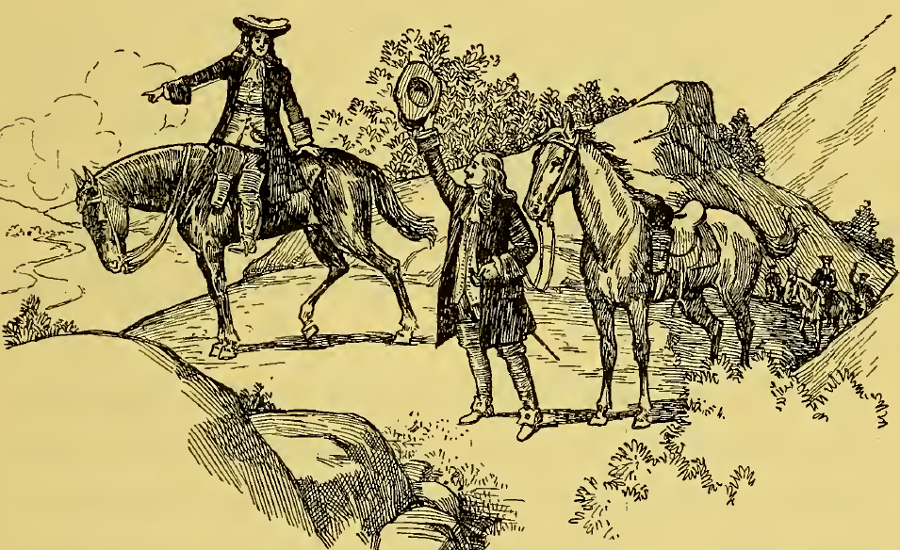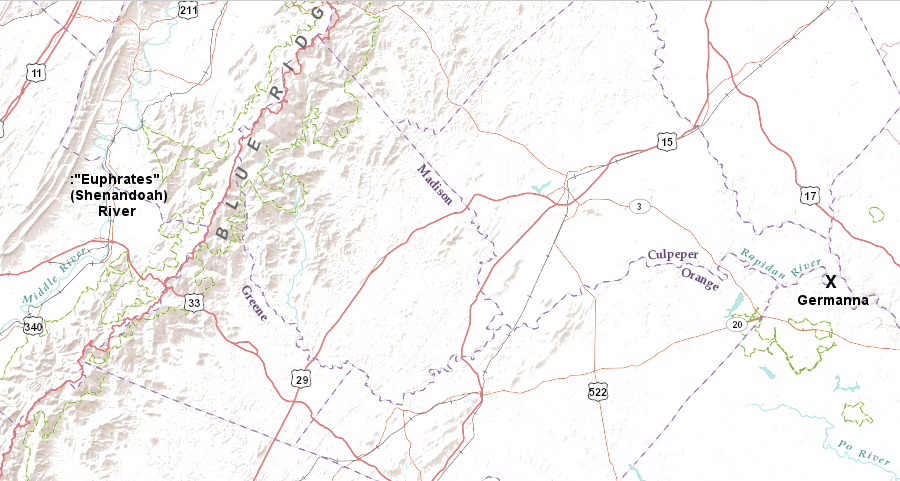 John Fontaine documented the expedition of Governor Spotswood and the Knights of the Golden Horseshoe across the Blue Ridge in 1716 Source: Makers of Virginia history (p.129) |
 John Fontaine documented the expedition of Governor Spotswood and the Knights of the Golden Horseshoe across the Blue Ridge in 1716 Source: Makers of Virginia history (p.129) |
John Fontaine's grandfather and father were Huguenots, French Protestants. They suffered official persecution by King Louis XIV, who revoked the Edict of Nantes in 1685 and ended over 80 years of political and religious toleration in France. Fontaine's father fled as a refugee to England, where John Fontaine was born in 1693. His father then migrated to Ireland, and succeeded in getting John a commission in an Irish regiment in 1710. John Fontaine served briefly in Spain, then investigated Virginia in 1715-19 before returning to England.
John Fontaine is remembered today primarily because he documented the 1716 expedition of Governor Alexander Spotswood across the Blue Ridge with the Knights of the Golden Horseshoes. Spotswood sought to entice settlement on the western edge of the colony, in the Piedmont and in the Shenandoah Valley, to block potential French encroachment from the Ohio River Valley.
According to legend, Spotswood gave small horseshoes as mementos of the trip. The horseshoes were small enough to be worn on a watch chain, and some may have had jewels attached. Horses in the sandy soils of Tidewater Virginia did not need to have iron horseshoes nailed to hooves to protect against stones and hard bedrock. After reaching Germanna, the "knights" prepared for the climb across the Blue Ridge by having the horses shod. That distinctive element of the trip was the basis for the mememtos supposedly distributed by the governor.1
The expedition across the Blue Ridge was far better supplied than John Lederer in 1670. In particular, Spotswood carried a wide variety of alcohol over the mountains. According to Fontaine's journal, the group crossed the "Euphrates" (Shenandoah) River on September 6, 1716, and the party that evening was memorable:2
 the Knights of the Golden Horseshoes left the Rapidan River at Germanna and crossed the Blue Ridge, perhaps through Swift Run Gap where US Route 33 crossses today Source: ESRI, ArcGIS Online |
Other Fontaines chose to settle in Virginia, including the two brothers of John Fontaine. His sister Mary Ann married Matthew Maury. Their son, Rev. James Maury, was the parson in the Parson's Cause case.
(Maury sued for his parish to pay him the market value of the tobacco that was dedicated to support of the Anglican ministers. The General Assenbly had passed a law that allowed the prish to offer a cash payment that did not reflect the short-term spike in prices. Maury won his case, but when a jury was required to determine the damages o which he wa entitled Patrick Henry first displayed his powerful oratorical skills. The jury awarded Maury only a token amount, and Henry became famous.)
Rev. James Maury's grandson was Commodore Matthew Fontaine Maury, the "Pathfinder of the Seas." He published The Physical Geography of the Sea, a seminal work in the science of oceanography. There is monument to Commodore Maury on Monument Avenue in Richmond, primarily because of his services to the Confederacy rather than to oceanography.
John Fontaine, the great-great uncle of Mathew Fontaine Maury, was also observant enough to notice the Gulf Stream. John Fontaine wrote in his journal on the way to Virginia in 1715:3